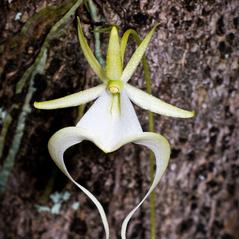Dendrophylax lindenii (Lindl.) Benth. ex Rolfe
Ghost Orchid, Palm Polly
Facts About
Accepted Synonyms: Aeranthes lindenii, Polyradicion lindenii, Polyrrhiza lindenii
Dendrophylax lindenii, the Ghost Orchid, grows in Cuba and the West Indies and Florida where it was known to occur in three southern counties. The Ghost Orchid is leafless with chlorophyllous roots that are gray-green in color with short white markings and are 3-5 mm wide to over 50 cm long. During May-August, a small percentage of the plants produce one white flower, rarely two, with sepals and petal that are similar. The labellum is 3-lobed with the center lobe triangular in shape, flanked by two elongated, tapered lobes. This orchid grows on several tree species in hardwood hammocks, tramways and sloughs, and cypress domes.
Although Dendrophylax lindenii is considered vulnerable across its range, in Florida, this orchid is endangered where it is threatened by illegal collection and disruption of wetland hydrology.
Pollination
It was once believed that the night flying Giant Sphinx Moth, Cocytius antaeus, was the only insect in North America with a long enough proboscis to reach the nectar in this orchid's long spur and pollinate its flowers. Recent field work has documented other moth species such as Eumorpha labruscae and Protambulyx shigilis visiting the flowers and two other moths, Dolba hyloeus and Pachylia ficus were observed with ghost orchid pollinia on their heads.
Ecosystem Type
Swamps, woodlands
Characteristics
- Habitat:
- epiphyte
- Number of leaves on stem:
- absent
- Form of the labellum:
- the labellum is not pouch-like
- Labellum outline:
- the labellum is lobed
- Main color of labellum:
- white
- Nectar spur:
- present
- Inflorescence type:
- the inflorescence has one flower or a pair of flowers
- Labellum characteristics:
-
- the labellum has a spur
- the labellum is lobed
- Labellum length:
- Up to 65 mm
- Sepal length:
- 21–25 mm
- Plant height:
- Up to 50 cm
-
Flowers
- Floral bract length:
- Up to 4 mm
- Flower petal color:
- white
- Flower symmetry:
- the flower is zygomorphic
- Flowering date:
-
- May
- June
- July
- August
May - August
- Flowers per inflorescence:
- 1–2
- Form of the labellum:
- the labellum is not pouch-like
- Hairs on flower stalk:
- the pedicel is hairless
- Hairs on inflorescence axis:
- the inflorescence stem is hairless
- Inflorescence length:
- Up to 250 mm
- Inflorescence type:
- the inflorescence has one flower or a pair of flowers
- Labellum characteristics:
-
- the labellum has a spur
- the labellum is lobed
- Labellum length:
- Up to 65 mm
- Labellum outline:
- the labellum is lobed
- Labellum position:
- the flowers are resupinate
- Length of peduncle:
- Up to 250 mm
- Lower petal strongly red-veined:
- no
- Main color of labellum:
- white
- Nectar spur:
- present
- Nectar spur length:
- Up to 120 mm
- Number of stamens:
- 1
- Orientation of side petals:
-
- the lateral petals are ascending
- the lateral petals are spreading
- Self-pollinating flowers:
- there are no cleistogamous flowers
- Sepal length:
- 21–25 mm
- Sepals fused only to sepals:
- the sepals are separate from one another
- Spots on labellum:
- no
-
Fruits or seeds
- Fruit length:
- 80–100 mm
- Fruit width:
- Up to 5 mm
-
Growth form
- Epiphyte form:
- This orchid only has roots; there are no stems or leaves
- Plant height:
- Up to 50 cm
- Roots:
- the rhizomes are non-coralloid
- myco-heterotrophic or not:
- the plant is chlorophyllous
-
Leaves
- Bract relative length:
- the bract is shorter than the associated flower
- Number of leaves on stem:
- absent
-
Place
- Ecosystem type:
-
- swamps
- woodlands
- Habitat:
- epiphyte
- Location:
- Florida
-
Facts and Uses
- Mycorrhiza
- Monitoring
- Propagation
- Restoration
Native to North America
Yes
North American Conservation Status & Distribution
Conservation Status
| Conservation and Wetland Status | |
|---|---|
| Global Rank | Vulnerable |
| US Status | N/A |
| Canadian Status | N/A |
| Conservation status for: Florida | |
|---|---|
| Global Rank | Vulnerable |
| US Status | N/A |
| Florida Rank | State Rare |
| Florida Status | Endangered |
| Canadian Status | N/A |
| Wetland Status | N/A |








